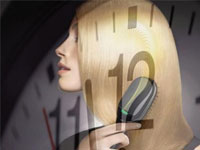
又熬了一个通宵?别不承认,科学家从你的头发中就能看出来。最新的一项研究发现,头发的毛囊能跟踪人体的生物钟。这一发现或许能够用于治疗睡眠紊乱疾病,或者用于评估需要倒夜班的工人的健康问题。
之前的研究者一直认为,人体的生物钟只存在于大脑中。但在上世纪90年代末期,科学家发现了掌管生物钟的基因之后,人们才开始相信我们身体中的每个部位都存在着生物钟。
有关生物钟的实验,都是在老鼠身上进行的。人们已经将生物钟基因同体重增加、吸食大麻引起的时间丧失感等症状联系了起来。但还没有人能够在人身上直接做实验。这主要是因为要分析这些基因,需要进行一些可能引起人体痛苦的实验,比如一天中要抽几次血,或者取下一块皮肤来进行化验。
最近,日本山口大学的Makoto Akashi和他的同事找到了一种简单的方法研究人体的生物钟活动,他们把注意力集中到了头发上。研究者先后化验了从头皮或者胡须上拔下来的毛发,它们含有大量的毛囊细胞。
在提取了这些细胞中的RNA后,研究者发现当受试者非常清醒的时候,生物钟基因的活动达到了高峰;而那些早上醒来最早的被试者,基因达到高峰的时间也最早。
接下来,研究小组打破了一些健康人的睡眠规律,观察生物钟的变化情况。在为期3周的实验中,受试者被要求一天比一天睡得晚,然后研究者在受试者醒来的半小时后加一个人工光源来模拟太阳。
在3周的实验结束后,受试者比最开始的时候晚睡了4个小时,而毛囊中生物钟基因的活动也相应地发生了变化,但只推迟了2.5个小时。研究人员将这一结果发表在最新出版的美国《国家科学院院刊》上。
Akashi的研究小组也在需要轮班工作的工人身上发现了同样的现象。这些人需要在第一周的早晨6点到下午3点上班,第二周则调整到下午3点到午夜上班,第三周再变回早晨上班。研究者发现,生物钟基因的活动比这些工人的生活规律延迟了5小时之多,这说明3周的时间不足以使人体生物钟适应新的生活节奏。
瑞士日内瓦大学的生物学家Ueli Schibler表示,通过毛囊来跟踪生物钟的活动,能够帮助科学家更好地监测患者的睡眠紊乱或其他生物钟节律失调症状。因为这些基因能够控制人体的许多生理活动,比如器官的正常运转、消化活动等,这个研究成果或许能够帮助人们解释许多由生物钟引起的健康问题。(生物谷Bioon.com)
生物谷推荐原文出处:
PNAS doi: 10.1073/pnas.1003878107
Noninvasive method for assessing the human circadian clock using hair follicle cells
Makoto Akashi a , 1 , Haruhiko Soma b , Takuro Yamamoto b , Asuka Tsugitomi c , Shiko Yamashita b , Takuya Yamamoto d , Eisuke Nishida d , Akio Yasuda b , James K. Liao e , and Koichi Node c
aResearch Institute for Time Studies, Yamaguchi University, Yamaguchi 753-8511, Japan;bLife Science Laboratory, Advanced Materials Laboratories, Sony Corporation, 5-1-12 Kitashinagawa, Shinagawa-ku, Tokyo, 141-0001, Japan;cDepartment of Cardiovascular and Renal Medicine, Saga University Faculty of Medicine, Saga 849-8501, Japan;dDepartment of Cell and Developmental Biology, Graduate School of Biostudies, Kyoto University, Kyoto 606-8502, Japan; and eVascular Medicine Research, Brigham and Women's Hospital, Cambridge, MA 02139
A thorough understanding of the circadian clock requires qualitative evaluation of circadian clock gene expression. Thus far, no simple and effective method for detecting human clock gene expression has become available. This limitation has greatly hampered our understanding of human circadian rhythm. Here we report a convenient, reliable, and less invasive method for detecting human clock gene expression using biopsy samples of hair follicle cells from the head or chin. We show that the circadian phase of clock gene expression in hair follicle cells accurately reflects that of individual behavioral rhythms, demonstrating that this strategy is appropriate for evaluating the human peripheral circadian clock. Furthermore, using this method, we indicate that rotating shift workers suffer from a serious time lag between circadian gene expression rhythms and lifestyle. Qualitative evaluation of clock gene expression in hair follicle cells, therefore, may be an effective approach for studying the human circadian clock in the clinical setting.







